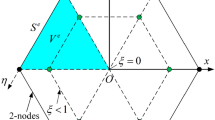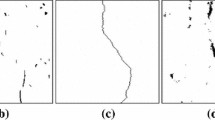Abstract
A method is proposed for automatic detection of cracks extracted from 2D images of damaged structures. In the 2D images, the cracks are treated as tree-like topological dark objects of which each tree branch is assumed to be line-like and have local symmetry across the crack center axis. Utilizing the geometric features of the cracks, a novel level set model in which the level set function comprises a set of B-spline basis functions is established to automatically extract the level set function from the 2D crack image with intensity inhomogeneity for crack detection. A new energy functional together with a crack measure technique is introduced to derive an iterative procedure for obtaining the exact level set function of the crack image via an optimization approach. In the iteration process, the level set model can produce smooth and continuous boundaries of the cracks with fast convergence speed. In a comparative study, it has been shown that the proposed method can extract cracks from several real noisy crack images of damaged structures made of various materials more accurate than those determined using the existing crack detection methods which use either different level set models or other image processing techniques in extracting the cracks.



















Similar content being viewed by others
References
Abdel-Qader, I., Abudayyeh, O., & Kelly, M. E. (2003). Analysis of edge detection techniques for crack identification in bridges. Journal of Computing in Civil Engineering, 17(3), 255–263.
Bernard, O., Friboulet, D., Thevenaz, P., & Unser, M. (2009). Variational B-spline level-set: A linear filtering approach for fast deformable model evolution. IEEE Transactions on Image Processing, 18, 1179–1191.
Chan, T. F., & Vese, L. A. (2001). Active contours without edges. IEEE Transactions on Image Processing, 10(2), 266–277.
Chen, Z. Q., & Hutchinson, T. C. (2010). Image-based framework for concrete surface crack monitoring and quantification. Advances in Civil Engineering, 2010, 215295.
Cornelis, B., Ružić, T., Gezels, E., Dooms, A., Pižurica, A., Platiša, L., et al. (2013). Crack detection and inpainting for virtual restoration of paintings: The case of the Ghent Altarpiece. Signal Processing, 93(3), 605–619.
De Schutter, G. (2002). Advanced monitoring of cracked structures using video microscope and automated image analysis. NDT & E International, 35(4), 209–212.
Dietenbeck, T., Alessandrini, M., Friboulet, D., & Bernard, O. (2010). Creaseg: A free software for the evaluation of image segmentation algorithms based on level-set. In Proceedings of 17th IEEE international conference on image processing (ICIP 2010) (pp. 665–668). Hong Kong.
Felsberg, M., & Sommer, G. (2000). A new extension of linear signal processing for estimating local properties and detecting features. Proceedings of the DAGM, 2000, 195202.
Felsberg, M., & Sommer, G. (2001). The monogenic signal. IEEE Transactions on Signal Processing, 49(12), 3136–3144.
Frangi, A., Niessen, W., Vincken, K., & Viergever, M. (1998). Multi-scale vessel enhancement filtering. Proceedings of Medical Image Computer Assisted Intervention, 1496, 130–137.
Fujita, Y., Mitani, Y., & Hamamoto, Y. (2006). A method for crack detection on a concrete structure. In Proceedings of 18th international conference on pattern recognition (ICPR ’06) (vol. 3, pp. 901–904). Hong Kong.
Fujita, Y., & Hamamoto, Y. (2011). A Robust automatic crack detection method from noisy concrete surfaces. Machine Vision and Applications, 22, 245–254.
Gonzalez, R., & Woods, R. (2002). Digital image processing (2nd ed.). New Jersey: Prentice-Hall.
Hacihaliloglu, I., Abugharbieh, R., Hodgson, R. N., & Rohling, R. N. (2009). Bone surface localization in ultrasound using image phase based features. Ultrasound in Medicine and Biology, 35, 1475–1487.
Hacihaliloglu, I., Abugharbieh, R., Hodgson, A. J., & Rohling, R. N. (2011). Automatic adaptive parameterization in local phase feature-based bone segmentation in ultrasound. Ultrasound in Medicine and Biology, 37(10), 1689–1703.
Hu, D. N., Tian, T., Yang, H. X., Xu, S. B., & Wang, X. J. (2012). Wall crack detection based on image processing. In Proceedings of 2012 third international conference on intelligent control and information processing (ICICIP) (pp. 597–600).
Huang, W. L., & Zhang, N. (2012). A novel road crack detection and identification method using digital image processing techniques. In Proceedings of 2012 7th international conference on computing and convergence technology (ICCCT) (pp. 397–400).
Huang, N. E., & Shen, S. S. P. (2005). Hilbert–Huang transform and its applications (Vol. 5). Singapore: World Scientific Publishing Company Incorporated.
Hutchinson, T. C., & Chen, Z. (2006). Improved image analysis for evaluating concrete damage. Journal of Computing in Civil Engineering, 20(3), 210–216.
Ito, A., Aoki, Y., Hashimoto, S. (2002). Accurate extraction and measurement of fine cracks from concrete block surface image. In Proceedings of IEEE 28th annual conference of the industrial electronics society (pp. 2202–2207).
Kovesi, P. (1997). Symmetry and asymmetry from local phase. Proceedings of tenth Australian joint conference on artificial intelligence (pp. 185–190). Australia.
Kovesi, P. D. (2013). MATLAB code for calculating phase congruency and phase symmetry. http://www.csse.uwa.edu.au/~pk/research/matlabfns/
Kovesi, P. (1999). Image features from phase congruency. Journal of Computer Vision Research, 1(3), 1–26.
Krissian, K., Malandain, G., Ayache, N., Vaillant, R., & Trousset, Y. (1998) Model based multi-scale detection of 3-D vessels. In Proceedings of IEEE Workshop on Biomedical Image Analysis (pp. 202–208).
Krissian, K., Malandain, G., Ayache, N., Vaillant, R., & Trousset, Y. (1999). Model-based detection of tubular structures. In 3d images, technical report 3736, INRIA.
Lankton, S., & Tannenbaum, A. (2008). Localizing region-based active contours. IEEE Transactions on Image Processing, 17, 2029–2039.
Li, L., Chan, P., & Lytton, R. L. (1991). Detection of thin cracks on noisy pavement images. Transportation Research Record, 1311, 131–135.
Li, C., Kao, C.-Y., Gore, J. C., & Ding, Z. (2008). Minimization of region-scalable fitting energy for image segmentation. IEEE Transactions on Image Processing, 17, 1940–1949.
Lindeberg, T. (1998). Edge detection and ridge detection with automatic scales election. International Journal of Computer Vision, 30(2), 117–154.
Muduli, P. R., & Pati, U. C. (2013). A novel technique for wall crack detection using image fusion. In Proceedings of 2013 IEEE international conference on computer communication and informatics (ICCCI) (pp. 1–6).
Nguyen, H. N., Cheng, P.-Y., & Kam, T. Y. (2012a) Deformable model for structural damage localization and quantification using radial basis functions based level set interpolation with an ellipse constraint. In Proceedings of international conference on applied and theoretical information system research, Taiwan.
Nguyen, H.-N., Kam, T. Y., & Cheng, P.-Y. (2012b). Crack image extraction using a radial basis functions based level set interpolation technique. In Proceedings of IEEE international conference on computer science and electronics engineering (ICCSCE 2012) (Vol. 3, pp. 118–122). China.
Nobuyuki, O. (1975). A threshold selection method from gray-level histograms. Automatica, 11(285–296), 23–27.
Oliveira, H., & Correia, P. L. (2013). Automatic road crack detection and characterization. IEEE Transactions on Intelligent Transportation Systems, 14(1), 155–168.
Osher, S., & Fedkiw, R. (2002). Level set methods and dynamic implicit surfaces. New York: Springer.
Padalkar, M. G., & Joshi, M. V. (2015). Auto-inpainting heritage scenes: a complete framework for detecting and infilling cracks in images and videos with quantitative assessment. Machine Vision and Applications, 26(2–3), 317–337.
Poli, R., & Valli, G. (1997). An algorithm for real-time vessel enhancement and detection. Computer Methods and Programs in Biomedicine, 52, 1–22.
Ruan, C. X., & Ruan, Q. Q. (2012) An effective feature for crack detection on train wheel surface. In Proceedings of 2012 IEEE 11th international conference on signal processing (Vol. 2, pp. 865–868).
Sigg, C., Peikert, R., & Gross, M. (2003). Signed distance transform using graphics hardware. In Proceedings of IEEE Conference on Visualization (VIS 2003) (pp. 83–90). Switzerland
Silven, O., Niskanen, M., & Kauppinen, H. (2003). Wood inspection with non-supervised clustering. Machine Vision and Applications, 13, 275–285.
Tong, X. H., Guo, J., Ling, Y., & Yin, Z. P. (2011) A new image-based method for concrete bridge bottom crack detection. In Proceedings of 2011 international conference on image analysis and signal processing (IASP) (pp. 568–571).
Yamaguchi, T., & Hashimoto, S. (2010). Fast crack detection method for large-size concrete surface images using percolation-based image processing. Machine Vision Applications, 21, 797–809.
Author information
Authors and Affiliations
Corresponding author
Rights and permissions
About this article
Cite this article
Nguyen, H.N., Kam, T.Y. & Cheng, P.Y. Automatic crack detection from 2D images using a crack measure-based B-spline level set model. Multidim Syst Sign Process 29, 213–244 (2018). https://doi.org/10.1007/s11045-016-0461-9
Received:
Revised:
Accepted:
Published:
Issue Date:
DOI: https://doi.org/10.1007/s11045-016-0461-9




